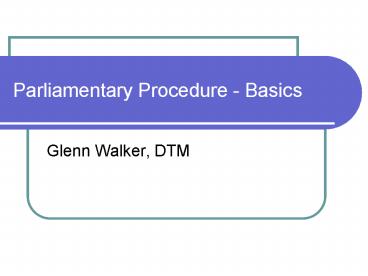Parliamentary Procedure Basics - PowerPoint PPT Presentation
1 / 14
Title:
Parliamentary Procedure Basics
Description:
Secretary keeps track of the motions and records the ones that pass. ... Adjourn the meeting. Question of Privilege. Orders of the day. Rise to Point of Order ... – PowerPoint PPT presentation
Number of Views:159
Avg rating:3.0/5.0
Title: Parliamentary Procedure Basics
1
Parliamentary Procedure - Basics
- Glenn Walker, DTM
2
Agenda
- Principles
- Players
- Making a Motion
- The Basic Motions
- Other Types of Motions
- Wrap Up and Questions
3
Principles
- Justice and courtesy to all
- Do only one thing at a time
- The majority rules
- The minority has the right to be heard.
4
Players
- Chairman oversees the conduct of the meeting.
- Secretary keeps track of the motions and
records the ones that pass. - Participant usually someone with voting rights.
But others can participate, if invited. - Mover a participant with voting privileges who
makes a motion. - Second another participant with voting
privileges that agrees a motion has merit to be
discussed.
5
Making A Motion
- Usually, the mover must be recognized by the
Chairman. - Mover states their motion.
- Chairman asks for a second.
- Chairman restates the motion and opens discussion
- Mover given first opportunity followed by second.
- Chair ensures balanced discussion.
- Chair conducts a vote by asking for all those in
favor and all those opposed.
6
Main Motion
- Most often used motion.
- Used to place a matter on the floor for
discussion. - Requires A second
- Is open to discussion
- Requires a simple majority vote.
7
Main Motion - Example
- I move that the club spend up to 50 to procure a
new lectern. - I move that the all members who arrive late be
fined 1.
8
Amendments
- Second most used form of motion.
- Used to make changes to a motion being discussed.
It must be germane. - Just like a motion it must be made, seconded,
discussed and voted on before discussion of the
item it interrupted can continue. - Basic formats include
- to add words
- to delete words
- to substitute words
- Only two active amendments are allowed at any
time.
9
Amendments - Examples
- I move to amend the motion by adding the words
by the time of our next business meeting. - I move to amend the motion by deleting the word
red that appears before wagon. - I move to amend the motion by substituting the
word dragon for horse.
10
The Hierarchy of Motions
11
Subsidiary Motions
- Motions that deal directly with the matter
currently on the floor for discussion. - An amendment is one type of subsidiary motion.
- Others Include
- Refer
- Postpone to a certain time
- Limit Debate
- Lay on the table
- Take from the table
12
Incidental Motions
- Motions that may or may not deal directly with
the matter currently on the floor for discussion. - Includes
- Objection to consideration
- Withdrawal of a motion
- Suspend the rules
- Appeal a decision of the chair
13
Privileged Motions
- Motions that do not relate to the motion on the
floor, but deal with important procedural matters
that must be dealt with immediately. - Includes
- Fix time of next meeting
- Adjourn the meeting
- Question of Privilege
- Orders of the day
- Rise to Point of Order
14
Summary
- Remember the principles.
- Learn the rules.
- Roberts Rules of Order, Newly Revised, 10th
Edition, Henry M. Robert III et al, Pegasus
Publishing - Roberts Rules of Order Simplified and Applied,
Robert McConnell Productions, a Websters New
World book. - Practice!































